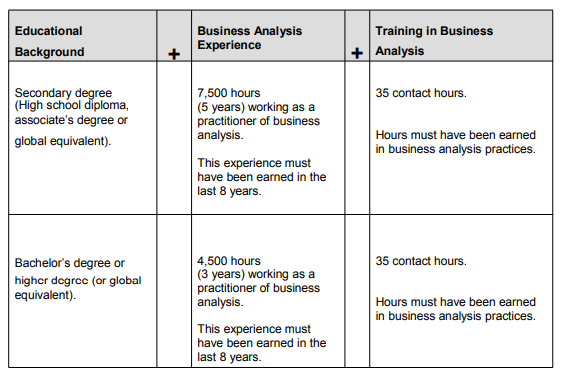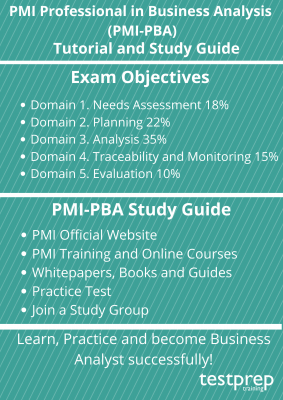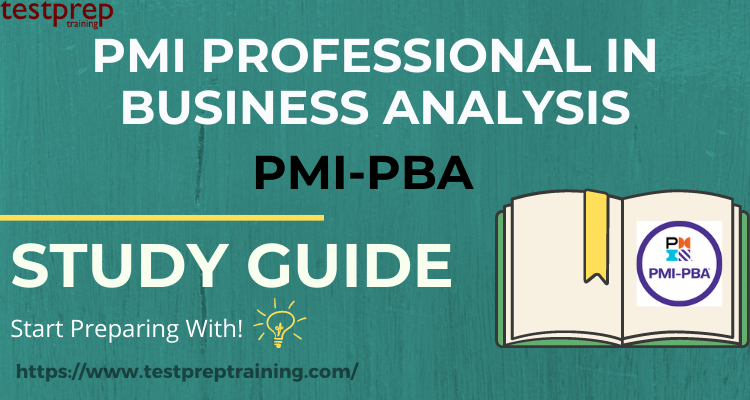PMI is well-known, and if you want a career in business analysis and managing resources in projects, then PMI-PBA is the right choice to consider. If you have made your choice to build a career or want to upgrade your skills for better learning opportunities then here is an ultimate learning guide to help you with all the study resources to prepare better. So before we start preparing let’s get some basic details of the exam so that we don’t miss on any learning concepts.
The PMI Professional in Business Analysis (PMI-PBA) certification recognizes someone’s skill in business analysis. Moreover, having the PMI Professional in Business Analysis (PMI-PBA)® Certification is highly respected in the professional world. To get it, you need a mix of business analysis training, hands-on project experience, and passing an exam about business analysis methods, practices, tools, and techniques. Moreover, this global certification also supports individuals in meeting the needs of organisations. These organisations rely on business analysis practitioners to play key roles on their teams. Therefore, becoming accredited as a business analysis (BA) expert provides your career in a fresh direction, given its increasing demand.
Who should take this PMI-PBA exam?
If the candidate works with project teams and manages requirements or product development, or if they are a project or program manager who performs business analysis in their role, then the PMI Professional in Business Analysis certification is the right choice for them.
PMI PBA Certification Requirements
- Secondary degree (high school diploma, associate’s degree
- Business analysis experience
- Education in business analysis
- Bachelor’s degree or the global equivalent

Since we have all details handy we will now start placing our cards so as to design a proper learning path for better preparation plan and with expert guidance to sail through swiftly.
Study Guide Professional in Business Analysis PMI-PBA Exam
Passing the PMI Professional in Business Analysis (PMI-PBA) exam is quite challenging. It requires a lot of dedication and determination. Fortunately, there are many study materials available to help you succeed in this exam. Using the right resources is crucial for doing well. Additionally, having a clear study plan will greatly assist in your preparation. So, this PMI PBA Study Guide will serve as a guide for your success and provide support throughout your journey to passing the exam.

Step 1- Visit PMI Official Website
Visiting the PMI official website is a necessary step while preparing for the PMI Professional in Business Analysis (PMI-PBA) exam. The official site proposes a lot of information and sources which is very important in preparing for the exam. You can find all such important things on the official page. Also, familiarising yourself with the exam course is really beneficial. This PMI Professional In Business Analysis (PMI-PBA)® Course covers the following 5 domains:
Domain 1: Needs Assessment
This domain focuses on concepts to define or review a business problem or opportunity using problem and opportunity analysis techniques. Also, collect and analyze information from a variety of sources using valuation tools and techniques to contribute to determining the value proposition of the initiative. Moreover, collaborate in the development of project goals and objectives by providing clarification of business needs and solution scope. Further, identify stakeholders by reviewing goals, objectives, and requirements in order that the appropriate parties are represented, informed and involved. Lastly, determine stakeholder values regarding the product, using elicitation techniques.
Domain 2: Planning
This domain aims at building an understanding to review the business case, and the project goals and objectives. Further, define strategy for requirements traceability using traceability tools and techniques in order to establish the level of traceability necessary to monitor and validate the requirements. Develop requirements management plan by identifying stakeholders, roles and responsibilities, communication protocols, and methods for eliciting, analyzing, documenting, managing, and approving requirements. Also, select methods for requirements change control by identifying channels for communicating requests and processes for managing changes. Select methods for document control by using documentation management tools and techniques. Moreover, define business metrics and acceptance criteria by collaborating with stakeholders for use in evaluating when the solution meets the requirements.
Domain 3: Analysis
This domain includes the concepts to elicit or identify requirements, using individual and group elicitation techniques. Also, analyze, decompose, and elaborate requirements using techniques such as dependency analysis, interface analysis, and data and process modelling. Further, evaluate product options and capabilities by using decision-making and valuation techniques. Moreover, allocate accepted or deferred requirements by balancing scope schedule, budget, and resource constraints with the value proposition using prioritization, dependency analysis, and decision-making tools and techniques. Not to mention, obtain sign-off on requirements baseline using decision-making techniques. Furthermore, requirements specifications using processes data, and interface details. Lastly, validate requirements using tools and techniques such as documentation review, prototypes, demos, and other validation methods.
Domain 4: Traceability and Monitoring
This domain covers the topics to track requirements using a traceability artifact or tools, capturing the requirements’ status, sources and relationships. Then, monitor requirements throughout their life cycles using a traceability artifact or tool. Also, update a requirement’s status as it moves through its lifecycle states by communicating with appropriate stakeholders and recording changes in the traceability artifact or tool. Moreover, communicate requirements status to project manager and other stakeholders using communication methods. Manage changes to requirements by assessing impacts, dependencies, and risks in accordance with the change control plan, and comparing to the requirements.
Domain 5: Evaluation
Lastly, this domain is much focused on concepts to validate the solution’s test results, reports, and other test evidence against the requirements acceptance criteria. Also, analyse and communicate the solution’s identified gaps and deltas using quality assurance tools and methods. Further, obtain stakeholder sign-off on the developed solution using decision-making techniques. Moreover, evaluate the deployed solution using valuation techniques.
Step 2- PMI Training and Online Courses
You can also opt for the PMI PBA Certification Online Training programs and online courses. PMI offers training programs on every exam. The training programs for a particular exam contain all information of the exam such as description, intended audience, delivery method, duration etc. Therefore, you should join a training program to gain knowledge and skills for PMI Professional in Business Analysis (PMI-PBA).
Step 3- Whitepapers, Books and Guides
The next step in the preparatory guide should be whitepapers, books and study guides. You need to find those books which are enriched with information. It is advised to refer the PMI-PBA Books from authentic and genuine resources only. Here, we are recommending some books and guides:

- The PMI Guide to Business Analysis Paperback by Project Management Institute.
- Business Analysis for Practitioners: A Practice Guide Paperback by Project Management Institute
- Achieve Business Analysis Certification: A Concise Guide to PMI-PBA®, CBAP® and CPRE Exam Success Pap/Psc Edition, by Klaus Nielsen
Step 4- Join a Study Group
Online forums and study groups play a critical role in preparing for an exam. Moreover, these forums help you learn from the experts. Also online forums are fruitful as they connect you with other candidates appearing for the same exam. Furthermore, they provide valuable insights in the certification and also bring clarity to your doubts. Therefore, joining an online group is essential part of your preparations.
Step5 – Self-Evaluate with Practice Test
Finally, it is time to self-evaluate. PMI PBA Practice Tests help you keep a check on your preparations. These tests familiarise you with the exam environment and also identify your weaker areas. Strengthening your weaker domains will surely help you pass the exam with flying colours. Attempting multiple tests will boost your confidence. Start Practising Now!



